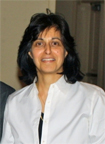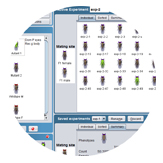 Dr. Mandana Sassanfar
Dr. Mandana Sassanfar
Title: Engaging Young Students in Research, Problem Solving and Troubleshooting
Group Meeting Date & Time: Wednesday, February 29, 2012 @ 3:00 pm
View the slides presented at this Education Group Meeting.
Dr. Mandana Sassanfar is a Biology Instructor and the Director of Diversity and Science Outreach in the Biology Department at MIT. She holds a B.S. and M.S. degrees in Biochemistry from the University of Pierre et Marie Curie and a Ph.D. in Biochemistry from Cornell University.
Dr. Sassanfar organizes numerous outreach activities that are all aimed at fostering research interests in high school students, high school teachers, and undergraduate students as well as providing them with the skills necessary to succeed in science. Through early research experiences, Dr. Sassanfar believes students’ interests in basic science and research will develop and continue to grow. During Dr. Sassanfar’s group meeting, she impressed upon the audience the need to increase the number of students who major in STEM fields. One challenge is how to attract students to research careers in STEM. Dr. Sassanfar has focused her attention on engaging students in the sciences by giving interactive lectures that illustrate findings from cutting edge biomedical research and fostering early research experiences. As the Director of Diversity and Science Outreach in the Biology Department at MIT, Dr. Sassanfar tries to attract students into research careers early on and teach them the set of skills that are necessary to succeed in research such as problem solving, experimental design, trouble shooting, scientific communication, and presentation skills. Her group meeting focused on recruiting undergraduate students, as well as two outreach events: the 2-week intensive IAP lab course and the summer workshop for high school teachers.

Images of bacteria strains isolated from the Charles River, Boston by students in the MIT course 7.391.
Dr. Sassanfar recruits students to participate in the numerous outreach activities that the Biology department offers, including students who are interested in obtaining a Ph.D. She visits many undergraduate institutions and gives engaging, interactive lectures that are designed to intrigue and excite students about science. Dr. Sassanfar starts these lectures by presenting the students with an unknown research result, typically from research ongoing at MIT biology labs. Then, by calling on students, she asks them first to describe what they see and make educated conclusions about the science in the experiment. She illustrated some of the examples she uses during her lectures and role-played the types of questions she asks students with the HHMI Education Group Meeting participants. By analyzing how well each student responds and thinks about the research questions at hand, Dr. Sassanfar can gauge how well the students will perform in a research laboratory. Using this strategy, she is able to consistently recruit students who do exceptionally well in the research laboratory.
One of the many outreach events in the Biology Department is an intensive lab course (MIT course 7.391) that is designed to introduce freshmen to research. This lab course is held for 2-weeks during the Independent Activities Period (IAP) for 12 students and it is worth 6 course credits. The teaching goal of this course is to introduce students to inquiry-based lab projects with unknown results which mimic the challenges and rewards of real laboratory science. The students are tasked with two projects: 1) isolate an unknown bacteria strain and 2) isolate bacteriophage (a virus that infects bacteria) that can grow on the newly isolated bacteria strain. This particular lab provides a medically-relevant context; students are told that a boy, while bathing in the Charles River, scraped his knee and contracted a severe bacterial infection that is resistant to all known antibiotics. The treatment is to either amputate the boy’s leg so that the infection does not spread or to isolate a bacteriophage from the same environment that can infect and kill the bacteria strain in question. Through the process of isolating the bacteria and bacteriophage from water from the Charles River in Boston, students are able to learn key experimental research skills, how to troubleshoot their experiments, and how to perform their own research project. The lab course serves as an early introduction to research and provides the freshmen with the training, experience, and confidence they need to join a lab through the UROP (Undergraduate Research Opportunities Program).

Electron microscope images of various bacteriaphages isolated from the Charles River, Boston by students in the MIT course 7.391.
Dr. Sassanfar also discussed one of the high school outreach events that she organizes – a high school teacher summer workshop. This workshop is designed to introduce teachers to different scientific topics and to help them develop novel, hands-on laboratory protocols that can be utilized in their high school classrooms. Each year, a different topic is chosen, such as the topic in 2011: “Microbial communities that grow on cheese and in the gut.” The summer workshop is composed of lecture and laboratory components. The teachers then focus on creating new laboratory protocols that can be easily implemented with limited resources and time. Additionally, the laboratory protocol must be easy to follow and not require any troubleshooting. Each year, at the end of the workshop, the teachers come up with novel laboratory protocols and activities to present science in new, intriguing ways to their students. For example, in 2011, teachers designed a participatory activity that illustrates the phenomenon of quorum sensing in bacteria using party favors noise makers. To see the rest of the laboratory and in-class activities designed in the 2011 teacher summer workshop, click here.

Left: MIT 7.391 student preparing a bacteriophage sample for EM. Right: Students in the 7.391 Lab Course drew "MIT" with colorful bacteria strains they isolated from the Charles River in Boston.
During her group meeting, Dr. Sassanfar told us of just a few of the numerous outreach events that she organizes each year. In addition to the outreach events Dr. Sassanfar spoke about during her group meeting, she organizes many other outreach activities to engage students and teachers in research. These experiences include high school class field trips to MIT as well as summer research internships for high school teachers. In addition, she organizes an intensive summer research internship program for advanced undergraduate students from institutions with few research opportunities. During IAP, Dr. Sassanfar also leads an intensive 6-day quantitative biology workshop for undergraduate students from partner minority-serving institutions. Additionally, Dr. Sassanfar coordinates the “HHMI special seminar” and the “Conversations with Scientists” series of talks. She is also involved in the selection of a faculty member from a minority-serving institution to participate in a summer mini-sabbatical program in a research laboratory at MIT. Dr. Sassanfar is also the Director of the Massachusetts Junior Academy of Science and has received the Summer Institute Award for Teacher Education by the Massachusetts Department of Education, a Certificate of Distinction in Undergraduate Teaching by the Derek Bok Center for Teaching and Learning at Harvard University, and special awards from Somerville High School and the University of Puerto Rico at Mayaguez. All of the outreach events organized by Dr. Sassanfar are all centralized around the main goal of fostering the next generation of scientists.



